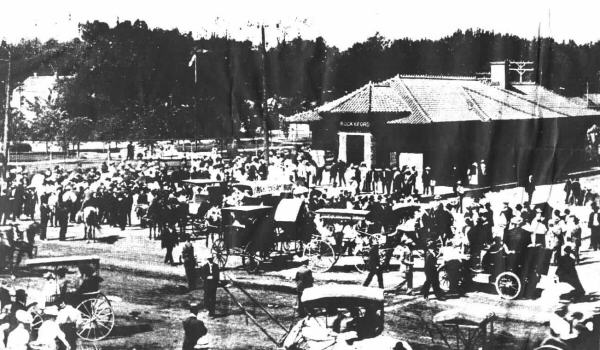The History of the Rocky Ford, Colorado Depot |
|
Daily Gazette Tuesday August 3, 1976 Rocky Ford, Colo. DOWN MEMORY LANERailroad Station --The Hub of Yesterday
BY D. K. SPENCER "Go west, young man" said Horace Greeley, and west they went, by all means of transportation, and particularly by railroad. Who can forget the wail of the steam engine's whistle and the "clickety-clack" of the rail car wheels over the rail joints, riding in comfort in the Pullman palace sleeping car, or in the seats of the coach as the iron horse carries you to the land of dreams and opportunity. If you were in a sleeping car, a Pueblo (Colorado) Chieftain newspaper article mentioned the arrival in Pueblo, via Rocky Ford of "The Plymouth Rock" in charge of the "very courteous and gentlemanly conductor, J. E. Williams" that made it's first trip in April 1876. "This car was magnificently furnished with all the modern conveniences for comfort available, and in a most tasteful and artistic manner". Your winter heating comfort would have been a wood or coal stove, and open windows in the summer for cooling. If you were a young family wanting to homestead or purchase property you no doubt read "flyers" from landholders of the west offering cheap land for a family to attach their roots to. An 1876 ATSF Railway Company timetable reads: "The Arkansas Valley Route from the Missouri River to Colorado and New Mexico. Up the valley of the Great Arkansas, Lovely Scenery, Sublime Views, Recreation, Health, Pure Mountain Air, Trout, Game, Antelope, Buffalo, Elk, the Foot Hills, Mountains and Canyons. The shortest route to Colorado Springs, Pikes Peak, and Manitou Springs, the Invalids Heaven. Mild Winters! Cool Summers! No Route so varied and picturesque. A delightful ride amid the magnificent scenery along the base of the ROCKY MOUNTAINS!! The only direct route to the famous San Juan mines!!" Fare from Kansas City to Colorado Springs was $35.00 sleeping car; $30.00 coach, and $20.00 emigrant, which probably was in a box car with your animals and personal effects. The ATSF Railway Company was offering 2,500,000 acres for settlement in the west, offering "best opportunities for farming or stock raising on the favorite 38th parallel which is equally adapted for corn, wheat, fruits, and cotton. Climate is mild and the soil fertility will allow settlers to pay for their land with the products raised thereon. It is not a wilderness, but a country settling rapidly with good society, newspapers, churches, markets, and schools with free education. Land prices from $2.00 to $9.00 per acre, with eleven years credit at 7% interest of choice valley land along the Cottonwood and Arkansas Rivers, with road to Pueblo for marketing, and good soil, abundance of pure water and timber, and coal deposits available on the railroad for supply to settlers." A typical train trip started at Kansas City at 11:30 a.m. on Monday, with a lunch stop at Topeka; dinner at Florence, Kansas; Tuesday breakfast at Lakin, Kansas; lunch at West Las Animas, Colorado and off the train at Rocky Ford at 4:06 PM. The daily train was No. 1, the Pueblo Mail and Express. This was 581 miles in 28 hours, and 36 minutes, with 20 minute meal stops along the way. Upon alighting in Rocky Ford you would be met by the local station agent who would help you with your luggage, and see to what other needs you might have. The station agent in 1876 is unknown, but in 1890 he would have been P. O. Rudolph. He would see to your comfort, especially in the winter, by getting you into the warmth of the waiting room with the pot-bellied stove fed by coal and wood as you pondered your next move. This was a common winter meeting place regardless of your status in life. After arrival at Rocky Ford, the engine would take on water and
fuel, and with great clouds of steam and smoke, screeching driver
wheels and the wail of the whistle, the train would disappear in
the distance and your train trip was over. You were now in the central meeting place of most prairie towns, for the arrival of the passenger trains was the social event of the day. Old friends were leaving, and new friends were arriving, bringing news of late happenings. Later years found the railroad bringing in trainloads of people for the Arkansas Valley Fair, and the annual Watermelon Day that began with George W. Swink, the first settler of the city sharing his bounty of watermelons by slicing them open on a railroad grain door for consumption by train passengers during the time of water and fuel replenishment. The black and white picture shows such a crowd shortly after the depot was built in 1907. If only this old depot could talk! There was even a marriage held here. A young couple was to be married on a certain date, and they requested a minister from Las Animas, Colorado to do the honors at a local church. The night before the wedding, high water washed out the tracks and he was stalled at La Junta, 10 miles away. The couple wondered if the wedding could be held by telegraph? A lawyer in La Junta could see no problem, so the couple were wed in the Rocky Ford depot! Over the country today, many depots are either gone or converted to other uses. Wouldn't it be nice to once again hear the wail of the steam locomotive's whistle as it glides through the night and across the prairies racing with the wind through the many towns it helped to build!
|








